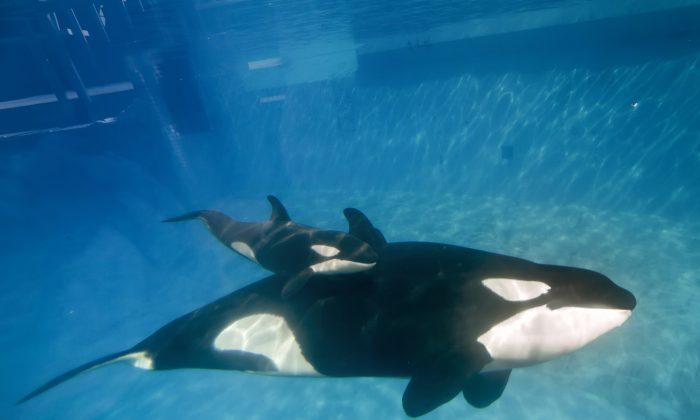SeaWorld President and CEO Joel Manby announced in a webcast that the company would be phasing out the killer whale theatrical performances and making new shows in 2017 that are “more natural and make the whole show and environment feel that way.” But the change, which appears to be in response to outcries from animal rights activists, was silent on a more pressing concern—captive breeding.
The announcement, made during an investor presentation on Nov. 9, comes amid an increasing number of challenges about captive breeding since the 2013 release of the documentary “Blackfish,” which saw the company’s shares fall by 37 percent, according to an NBC News report.
The documentary focuses on a bull orca named Tilikum, who is responsible for three deaths during his time in captivity, the most recent being a trainer at SeaWorld in 2010. The documentary argues “that placing the animals in captivity made them violent, neurotic, and decreased their life span.”
Some activists who have been increasing pressure on the entertainment company say ending the performances is a step in the right direction, but still not enough.
California lawmaker Richard Bloom, who introduced legislation to ban captive orca display and breeding, said in a statement that Manby’s announcement “ignores the critical issues of ending captive breeding and providing for the long-term care of the current group of orcas.”
Recounting the concerns of many activists who oppose animal captivity, Bloom said orcas are too socially and ecologically complex to be kept in a swimming pool-size habitat. In the wild, orcas travel up to 100 miles per day.
The California Coastal Commission granted a conditional development permit to SeaWorld in September for expansion of its San Diego orca facility, which includes constructing a 5.2 million gallon pool. The approval is conditional on SeaWorld agreeing to ban captive breeding of orcas, which prompted the company to announce its intention to pursue legal action against the commission.
A marine biologist who studies the eating habits of orcas in the wild says SeaWorld has done some great work. Daniel Costa, an ecology and evolutionary professor at University of California, Santa Cruz said he is not among the people who think SeaWorld should close down its orca facility.
“I think SeaWorld has a great role to play in terms of public education and research,” he said. He marveled at the company’s proposed new facility noting its unparalleled capability to maintain animals in captivity.
“What they’re proposing to do in terms of the size of their tanks and breeding facilities is unprecedented,” he said.
According to Costa, who recently talked to leaders at SeaWorld, the company has spent a large sum of money for significant research. He applauded the trainers and other workers for being “incredibly dedicated.”
Meanwhile, some former SeaWorld customers filed a class action lawsuit in March in the United States District Court Southern District of California. The lead plaintiff accuses the company of abusing orcas and says the public wouldn’t go there if they knew the truth.
Attorney for the plaintiffs, Steve Berman of Hagens Berman, said via email that the lawsuit helped push SeaWorld to make its recent decision, but says it’s still not enough.
“We will keep fighting SeaWorld’s failure to tell the truth about its treatment of orcas at other parks,” he said.
Among a number of allegations, plaintiffs say SeaWorld drugs the orcas and subjects them to psychological manipulation and at times food deprivation. They also accuse the company of forced breeding and inbreeding of young female whales.
Manby, who took the helm at SeaWorld seven months ago, said in the webcast that 23,000 employees have been running the parks very well for that past 20 years, and the company has been successful for 50 years. He acknowledged that there have been increased challenges in the last 24 months, but said the orca performance change was solely based on “what evolving guests tell us” and not because of what activists are saying.
Manby also said the more natural show has already been done for smaller groups as educational experiences. Now they will move it to the main show. As for the activists, Manby doesn’t think anything he does will satisfy them.
“Frankly, the activists aren’t going to be pleased with anything that we do, I think, so that wouldn’t be a good justification to make any move,” he said.





